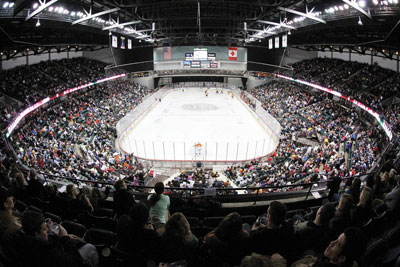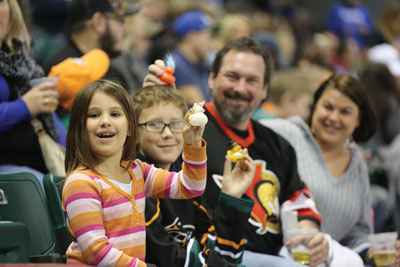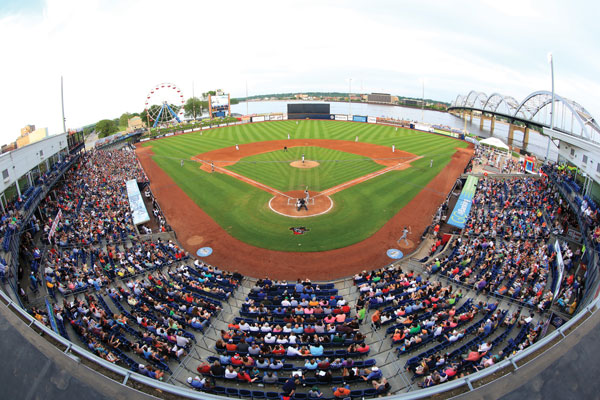 |
Professional baseball has been a mainstay of the Quad Cities market since 1946. This year, the River Bandits are poised to break the franchise’s attendance record.
Photo by: SEAN FLYNN PHOTOGRAPHY
|
There’s a ballpark in Iowa where the players emerge from a cornfield and step out onto the diamond. And as you sit down the right-field line, in the shadow of the majestic Centennial Bridge, and you watch the lights from the 110-foot-tall Ferris wheel in left field reflect off the adjacent Mississippi River, you can almost hear James Earl Jones’ voice beckoning you.
It’s not heaven. It’s the No. 1 market in our ranking of the nation’s top minor league markets for 2015.
| RANK |
MARKET |
| 1 |
Quad Cities (Moline-Rock Island, Ill./Davenport-Bettendorf, Iowa) |
| 2 |
Toledo, Ohio |
| 3 |
Fort Wayne, Ind. |
| 4 |
Tulsa, Okla. |
| 5 |
Charleston, S.C. |
| 6 |
Des Moines, Iowa |
| 7 |
Sioux Falls, S.D. |
| 8 |
Inland Empire, Calif. |
| 9 |
Hershey-Harrisburg, Pa. |
| 10 |
Grand Rapids-Comstock Park, Mich. |
The Quad Cities, a region in southeast Iowa and northwest Illinois, lies 90 miles south of the ballpark site made famous in “Field of Dreams.” But unlike in the movie, the players at this ballpark — Davenport, Iowa’s Modern Woodmen Park, home of the Class A Quad Cities River Bandits — are hoping to be future stars. And here, all the fans can see them.
Joining the River Bandits as teams that call the Quad Cities home are the Clinton (Iowa) LumberKings, who also compete in the Midwest League, and the ECHL Quad City Mallards, who play across the river from Davenport in Moline, Ill. In their most recently completed seasons, the three clubs attracted 497,531 fans to their games, just 1,081 below the market’s all-time high generated six years ago. The teams’ collective attendance has increased in each of the past four years, and the 11 percent growth rate seen over that time is more than five times the market’s population growth rate during the same period.
Support for the teams extends beyond the gate. Both the River Bandits and the Mallards are playing in facilities that have been extensively updated in the past five years.
It all leads to a No. 1 ranking that reflects something River Bandits’ co-owner and managing partner Dave Heller sees daily.
“When you have a city and you have a state that is supporting the team and the venue, that’s a great market,” Heller said. “When you have two states and two cities that are doing it, all in the same market — what more could you ever ask?”
■ ■ ■ ■
Modern Woodmen Park was built in 1931 as a Works Progress Administration project under President Franklin D. Roosevelt’s New Deal. It has been home to professional baseball almost continuously since 1946.
In 2004, the ballpark received a $12.5 million renovation, but times in the Quad Cities then were not what they are today. In the three years following that renovation, attendance at the ballpark dropped a total of 14 percent.
It was into that situation, sensing an opportunity, that Heller and Bob Herrfeldt arrived. The duo purchased the team, then know as the Swing of the Quad Cities, following the 2007 season. Within weeks of the purchase, the team announced it would drop the 4-year old “Swing” moniker and return to the name Quad Cities River Bandits, which it had carried from 1992 until 2003.
“I looked at a half-dozen or so different markets,” Heller said. “I bought the team because I fell in love with the ballpark and felt the market had a tremendous amount of upside.”
Merchandise sales in 2008 soared more than 400 percent, and sponsorships jumped nearly two-thirds in that first, rebranded season.
The club also signed a 20-year, $4.5 million naming-rights deal with Modern Woodmen of America, a company that has been based in the Quad Cities since 1897. The money would serve as seed for what has become an almost annual stadium upgrade plan. Combining those funds with public financing, Heller has orchestrated the installation of a new playing surface, development of the Sky Deck, the Pepsi Loge Boxes, the Miller Lite Party Deck, a new high-definition video board and LED ribbon board since acquiring the club. Oh, and a cornfield.
That’s right. Every game beginning in mid-June when the corn gets tall enough, players enter the ballpark after walking through the Crop Production Services Corn Field, a small patch of corn originally planted in 2008 and located down the left-field line.
In 2010, the ballpark was the beneficiary of a state grant, via the American Recovery and Reinvestment Act of 2009, that was used to build a flood protection system to protect the stadium from the Mississippi River’s unpredictable waters. The ballpark has suffered through numerous costly floods through the years, including in 1993 and 2001.
In 2011, the Bandits unveiled their new Budweiser Champions Club, a 2,500-square-foot banquet hall with glass garage doors that open and close depending on the weather. Today, Heller says the club does more weddings at the ballpark every year than any other team in the Midwest League, “by far.”
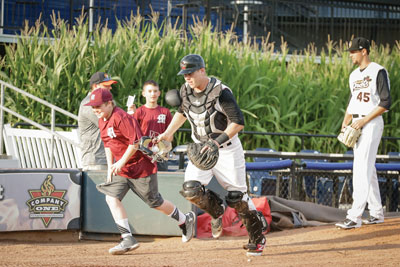 |
Playing off Iowa’s “Field of Dreams” heritage, the River Bandits emerge from a cornfield.
Photo by: QUAD CITIES RIVER BANDITS
|
But Heller’s favorite addition came in 2012, when he provided the initial funding for the construction of the Ferris wheel, though the city will repay him over a five-year period. At roughly a dollar a pop, half of which goes to local charity, Heller said 68,000 fans rode the Ferris wheel last season, more than the number of people who attended the city’s publicly funded art museum.
Most recently, the team earlier this month concluded an expansion that added 10,000 square feet to the third-base concourse. The River Bandits again are paying the upfront costs of the project, with the city of Davenport paying them back over seven years.
“When I am evaluating teams, the No. 1 thing I look at is, ‘To what degree does the market support the venue?’” said Heller, whose Main Street Baseball, the holding company through which he owns the River Bandits, also owns the Class A High Desert (Calif.) Mavericks, Rookie League Billings (Mont.) Mustangs and Class A Wilmington (Del.) Blue Rocks. “In the Quad Cities, the municipality invests in the venue every single year. It’s a unique partnership.”
Just under $4 million has been spent in ballpark improvements over the past five years, he said. And the investments clearly are paying off. Average attendance last year was 3,885 fans per game, an all-time high for the franchise and up 72 percent from 2007, the year before Heller’s Main Street bought the team. This season, the club is poised to match last year’s record average per game and possibly could break its single-season total attendance record of 260,000 set in 1994.
“We have a waiting list for outfield signs, corporate sponsorships are up 15 percent over last season, weddings and special events are up 12 percent this year, and concessions per caps are up 6 percent over last season,” Heller said. And ticket sales for the Ferris wheel? “Up a whopping 24 percent over last season,” he said, giddily.
People outside of the Quad Cities have taken note, too. Modern Woodmen Park was named, separately, as the nation’s best minor league ballpark in recent years by USA Today and Baseball America. In addition, the Ferris wheel was named by Ballpark Digest as “the nation’s best ballpark improvement.”
■ ■ ■ ■
From atop the Ferris wheel, fans who look about four miles down river will see the lights of the iWireless Center, home of the Mallards. There, inside his arena office, a carnival ride of a different sort may very well be on team owner Jordan Melville’s mind when he describes the club that his company purchased in 2012.
“We got a broken toy,” Melville says.
But it is the extent that he has repaired that breakage that played a key part in the Quad Cities’ rise to No. 1.
Moline, Ill., has supported a professional hockey team since 1995. The Quad City Mallards of the Colonial, then United, Hockey League, drew more than 8,000 fans per game from 1997-98 through 1999-2000, and on the ice, the team won 50 or more games in six straight seasons. But the gradually increasing instability that was permeating the league offices throughout all levels of minor league hockey in the last decade began to affect the product on the ice. The Mallards at various times played in the Central, United and International leagues, each of which are now defunct. And not being able to promote rivalry games affected the club’s ticket sales. By 2010-11, the Mallards were drawing an average of only 2,870 fans per game, down two-thirds from the club’s all-time high of 8,646 a game in 1997-98, and the worst average ever for professional hockey in the city.
The team also began an era where ownership was a revolving door.
On May 11, 2011, Eric Karls, a Vancouver native who made his fortune in the clothing business, decided to cease operations for the club only 10 months after purchasing the team, citing sustained and heavy financial losses. A few weeks later, Club 9 Sports, a consortium among
Chicago-based investment bank Prometheus Capital Partners, management and consulting firm Tobacco Road Capitalists, and sports management and marketing firm ScheerSports bought the rights and resurrected the club. But the team continued to be on thin ice.
Just 17 months later, the Central Hockey League took over ownership of the team.
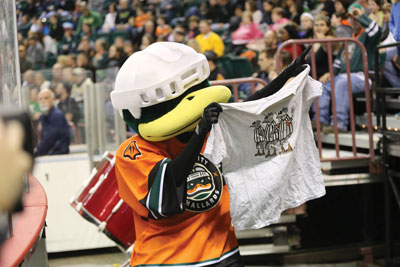 |
After several ownership changes, the Quad City Mallards are pointed in the right direction and all business metrics are up.
Photo by: QUAD CITY MALLARDS (3)
|
“We just had no confidence in the direction the club was going,” said Melville, whose Vancouver-based T&M Management Services owned the CHL.
Lawsuits from vendors and corporate partners ensued, targeting Karls. Gate and corporate revenue dwindled.
In October 2012, QCM Holdings, a subsidiary of T&M Management Services, whose portfolio also includes Boston Pizza and Mr. Lube, took over ownership of the club. It was the club’s fifth owner in seven seasons.
Bob McNamara, who had been general manager of the AHL Grand Rapids (Mich.) Griffins for the past 15 seasons, was named by Melville to be the Mallards’ president three months later and was charged, as he puts it, “to bring back the quack.”
But it was a rough start. In 2013, the CHL was rumored all summer to be closing, and heading into McNamara’s first full season, it was impossible for the team to sell tickets or sponsorships.
“It was a month before the season started, and we still had no players signed,” said McNamara, still team president and alternate governor for the Mallards. “We got the 2014 schedule two weeks before the season began.”
The ECHL ultimately admitted the remaining seven members of the CHL just days before the start of the 2014-15 season.
Since that rocky start, Melville says, revenue is up across all metrics.
“The dark ages are over, but we still need to gain back the trust of the fans and the corporate base,” he said, adding that corporate revenue has doubled in each of the three seasons since taking over the team and that those sales will be up another 20 percent heading into the 2015-16 season.
Last season, TGI Friday’s signed a deal to put its logo on the Mallards’ game jerseys and is returning this fall, a sign that businesses are starting to feel the team is secure.
| Year |
No. 1 market |
| 2005 |
Rochester, N.Y. |
| 2007 |
Fort Wayne, Ind. |
| 2009 |
Hershey-Harrisburg, Pa. |
| 2011 |
Hershey-Harrisburg, Pa. |
| 2013 |
Toledo, Ohio |
| 2015 |
Quad Cities (Illinois-Iowa) |
McNamara boasts that full-season-ticket renewals for 2015-16 are at 87 percent. As of the end of July, he said, the club has almost hit its target of a 25 percent increase in overall season-ticket revenue compared to last season. And, he added, the league finalized the 2015-16 schedule in April, which has helped the marketing and ticket folks sell more, particularly with group sales, which will make up about 30 percent of gross ticket sales this season.
One obstacle, however, is a peculiar nuance of the market: the propensity of fans to wait until game day to purchase tickets.
“I’ve never seen anything like it,” McNamara said. “On a typical Friday, we’ll sell 1,000 tickets between 10 a.m. and 4 p.m., then another 2,000 walk-ups once the doors open.”
That’s a big number for a team that averaged 3,900 fans per game last season.
Heller, of the River Bandits, echoed the walk-up frustration. “Even though our club typically finishes around sixth in a 16-team league in attendance — we will always be behind much larger markets such as Dayton, Grand Rapids, Fort Wayne and Kane County — we regularly lead the league in walk-up sales,” he said. “It is simply a late-deciding market, which makes advertising critically important and weather a big deal.”
Helping draw people on game days to see the Mallards is the public money that’s helped make the 22-year-old iWireless Center increasingly fan friendly. The arena has had $6 million in upgrades during the past three years. The biggest improvement, a $5 million expansion to the arena’s concourses and box office, is scheduled to wrap up next month. That project was funded by the state of Illinois.
The city of Moline, for its part, contributes to capital improvements through an account funded by a 3 percent amusement tax on tickets. The account generates up to $300,000 per year, according to the city’s annual report.
Since Melville took over the team, the Mallards have increased their attendance each year for an overall jolt of 33 percent across the three seasons. The club made the playoffs in each of those three years after making it to the postseason only once in the previous five seasons.
When it’s all added up, Melville said he expects the team to break even financially this year.
■ ■ ■ ■
Rounding out the Quad Cities sports market are the Class A LumberKings of Clinton, Iowa, 30-some miles to the north of iWireless Center. The LumberKings are the only remaining charter member of the Midwest League and have operated continuously since 1954. The club is community-owned and governed by a 24-person board of directors, five of whom form the executive board.
Like Modern Woodmen Park, Ashford University Field is located on the banks of the Mississippi River and was built as a Works Progress Administration project. The ballpark underwent a $3.8 million renovation leading up to the 2006 season, and Ballpark Digest in 2010 wrote, “There are very few ballpark renovations carried out as successfully as the overhaul of Ashford University Field in 2005-06.”
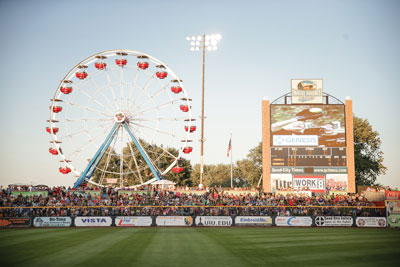 |
River Bandits owner Dave Heller added the Ferris wheel in 2012, a unique touch that delivered 68,000 rides last season.
Photo by: QUAD CITIES RIVER BANDITS
|
The club does not draw as well as its market brethren, filling just 42 percent of its seats over the past five seasons. But its average of 1,600 to 1,800 fans per game has remained steady over the past eight years and aligns with the market’s low rate of population growth, and its 62-year tenure carries weight in our methodology.
Not every team in the market maintained such consistency.
The area was home from 2000-09 to the Quad City Steamwheelers, an af2 team. The team drew well in its early years, while going 31-1 and winning the league’s first two championships. But attendance dropped from more than 8,000 per game in those first two seasons to less than half that during the final four years, and the league and team shuttered after the 2009 season. In fact, it was the early success of that franchise that pushed the market to its previous high of sixth in our 2007 study. That team’s failure also knocked Quad Cities to its survey low (86th) in 2011.
But like the muddy river that snakes its way through the area’s towns, the Quad Cities’ sports scene endures.
“It’s been a successful minor league market for decades,” Melville said. “And all the signs are there for a strong future.”




